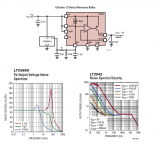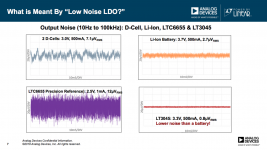Hi,
the noise at the LT3045s output is dominated by the noise generated by the voltage setting resistor and the current through it. This is because the LT3045´s internal error amplifier is just a Buffer, hence with a gain - and a noise-gain- of 1.
To reduce the noise generated by the resistor the cap is paralleled.
However, below the breakpoint frequency of the RC network noise rises again up to the value of the resistor alone.
Now the output of the LTC6655 is almost 0 and it feeds into the set pin via the 1k resistor.
Its lowfreq noise contribution is alot lower than the 49k9 resistor´s .
Also the vast majority of the LT3045s setting current is routed away from the voltage setting resistor and through the LTC6655 +1k.
If the OPAmp is a chopper stabilized type, there is even no 1/f rise, hence this would show the lowest noise contribution.
jauu
Calvin
the noise at the LT3045s output is dominated by the noise generated by the voltage setting resistor and the current through it. This is because the LT3045´s internal error amplifier is just a Buffer, hence with a gain - and a noise-gain- of 1.
To reduce the noise generated by the resistor the cap is paralleled.
However, below the breakpoint frequency of the RC network noise rises again up to the value of the resistor alone.
Now the output of the LTC6655 is almost 0 and it feeds into the set pin via the 1k resistor.
Its lowfreq noise contribution is alot lower than the 49k9 resistor´s .
Also the vast majority of the LT3045s setting current is routed away from the voltage setting resistor and through the LTC6655 +1k.
If the OPAmp is a chopper stabilized type, there is even no 1/f rise, hence this would show the lowest noise contribution.
jauu
Calvin
You see in the plot that the LT3045 has a low noise at 10 Hz thanks to filtering of its reference. For low values of the filter capacitance, the noise is as high as 800 nV/sqrt(Hz) for 3.32 V output voltage (hence around 1.2 uV/sqrt(Hz) at 5 V). This is not mainly the resistor's noise, but the voltage drop across the resistor caused by noise of the LT3045's 100 uA reference current.
The LTC6655 has a flat 90 nV/sqrt(Hz) line down to 10 Hz without any filtering. Hence, for frequencies where filtering is unpractical (say at 0.1 Hz), the LTC6655 is bound to outperform the LT3045's built-in reference.
The LTC6655 has a flat 90 nV/sqrt(Hz) line down to 10 Hz without any filtering. Hence, for frequencies where filtering is unpractical (say at 0.1 Hz), the LTC6655 is bound to outperform the LT3045's built-in reference.
... LTC6655 is bound to outperform the LT3045's built-in reference.
LTC6655 is a tiny part designed to provide low noise without any additional filtering. with 22uF cap LT3045 will peak at 10Hz 20 nV/sqrt(Hz). at higher f its noise density is considerably lower.
Attachments
@ Calvin,
I just realized that LTC6655 is capable of sinking current. My understanding is that 1k resistor could form a voltage drop so that LTC6655 will sink most of the current from LT3045's Iset pin hence reduce the noise of the 49.9k resistor.
@MarcelvdG,
It looks like low frequency noise can benefit from LTC6655, but there is compromise on higher frequency.
@eziitis,
This is interesting. The higher frequency noise completely dominates the output of LTC6655...
I just realized that LTC6655 is capable of sinking current. My understanding is that 1k resistor could form a voltage drop so that LTC6655 will sink most of the current from LT3045's Iset pin hence reduce the noise of the 49.9k resistor.
@MarcelvdG,
It looks like low frequency noise can benefit from LTC6655, but there is compromise on higher frequency.
@eziitis,
This is interesting. The higher frequency noise completely dominates the output of LTC6655...
Last edited:
eziitis, you are quoting me out of context, I was writing about very low frequency noise.
Peak at 10 Hz? That would be very unusual, I never heard of a voltage reference of which the noise peaks at 10 Hz and drops at even lower frequencies. At sufficiently high frequencies you can get rid of the noise of any reference by low-pass filtering.
Peak at 10 Hz? That would be very unusual, I never heard of a voltage reference of which the noise peaks at 10 Hz and drops at even lower frequencies. At sufficiently high frequencies you can get rid of the noise of any reference by low-pass filtering.
the LTC6655-5 isn't quite a low 1/f noise reference. From the diagram, the LT3045 shows 20nv/sqrt(Hz) @ 10Hz (22uf Cset) whereas the LTC6655 is 90nv/sqrt(Hz) @ 10Hz. Any one?
Isn't 1/f noise is the flicker noise below 10Hz? It's another source of noise instead of the wideband noise above 10Hz. Then, there is nothing wrong with the LT's engineer claim.
The real question is how all of these (including other factors than noise) affect subjective listening when we talk about audio instead of measurement accuracy in instrumentation? 😕
Notice that the output of the LTC6655 (as reference voltage for LT3045) is also filtered, improving the wideband performance of its output.
I
The real question is how all of these (including other factors than noise) affect subjective listening when we talk about audio instead of measurement accuracy in instrumentation? 😕
there are some reports that sound is improved using LTC6655 instead of LT304X in AVCC buffers, for instance in "ES9038Q2M board" thread.
subjectively for me, output impedance, low and flat in the audio range would be the priority.
It could cause sidebands around the signal if this supply is used as the voltage reference for a DAC, for example, or as a supply for its clock generator. It would probably have to be very bad for this to become noticable, though.
The real question is how all of these (including other factors than noise) affect subjective listening when we talk about audio instead of measurement accuracy in instrumentation? 😕
In fact, I found 1/f noise is somehow an important factor for audio. If you take it into consideration on every part of your design (regulator, DC servo, op amp...etc), the effect is pretty obvious - much clearly defined bass.
Poting
there are some reports that sound is improved using LTC6655 instead of LT304X in AVCC buffers, for instance in "ES9038Q2M board" thread.
subjectively for me, output impedance, low and flat in the audio range would be the priority.
This is interesting: the relationship between audio quality and the power supply impedance.
This is a concept that, for me at least, was introduced by Walt Jung in The Audio Ameteur magazine.
They carried out some tests measuring and comparing output impedance from several regulators, and they were published in two articles.
At the time, Sulzer's regulator won the medal as lowest.
Later on Jung did more tests, more accurate, this time as the basis for his first super regulator version, where Jung's regulator could improve on Sulzer's, also adding more design tricks, like ground tracks splitting and zeroing irregularities caused by the link to the powered device.
None of these low noise regulator, like LT3042 or LT3045, or others, seem to pay attention to output impedance curves.
Have you seen impedance curves for these LT devices? What would be your suggestion for a low impedance power supply design using the 3042 or 3045?
Hi,
the noise at the LT3045s output is dominated by the noise generated by the voltage setting resistor and the current through it. This is because the LT3045´s internal error amplifier is just a Buffer, hence with a gain - and a noise-gain- of 1.
To reduce the noise generated by the resistor the cap is paralleled.
However, below the breakpoint frequency of the RC network noise rises again up to the value of the resistor alone.
Now the output of the LTC6655 is almost 0 and it feeds into the set pin via the 1k resistor.
Its lowfreq noise contribution is alot lower than the 49k9 resistor´s .
Also the vast majority of the LT3045s setting current is routed away from the voltage setting resistor and through the LTC6655 +1k.
If the OPAmp is a chopper stabilized type, there is even no 1/f rise, hence this would show the lowest noise contribution.
jauu
Calvin
Thanks for the explanation.
I read your website and truly enjoyed it. Very nice.
Regards,
Nick
In fact, I found 1/f noise is somehow an important factor for audio. If you take it into consideration on every part of your design (regulator, DC servo, op amp...etc), the effect is pretty obvious - much clearly defined bass.
Can you clarify. Low 1/f noise is important even tho wideband noise is slightly high? I have several months ago collected several voltage reference ICs to be compared in Jung's super regulator, to find out what matters for the ears among the so many aspects.
Can you clarify. Low 1/f noise is important even tho wideband noise is slightly high? I have several months ago collected several voltage reference ICs to be compared in Jung's super regulator, to find out what matters for the ears among the so many aspects.
Hi,
I'm not no expert on this. Before this thread, I was convinced that corner frequency is usually the bottom line of the entire noise spectrum. There are maybe exceptions, but most op amps or LDOs follow this pattern. From my experience, wide band noise is the most important for digital circuits. However, if 1/f noise were also taken care of, you may notice some gain on performance.
Poting
Hi,
I'm not no expert on this. Before this thread, I was convinced that corner frequency is usually the bottom line of the entire noise spectrum. There are maybe exceptions, but most op amps or LDOs follow this pattern. From my experience, wide band noise is the most important for digital circuits. However, if 1/f noise were also taken care of, you may notice some gain on performance.
Poting
Thanks for the clarification...
I'm not no expert on this.
Oops, just notice a typo…
By the way, what's your preferred reference? Have you tried Jung's LED reference? I found it's quite good.
Poting
By the way, what's your preferred reference? Have you tried Jung's LED reference? I found it's quite good.
No, I haven't, I couldn't find the Zetex part. I have several LEDs and zeners (that I can pick the best one by hand), LM329 and 3-legged metal cans from Analog Device but never used a more sophisticated ICs.
No, I haven't, I couldn't find the Zetex part. I have several LEDs and zeners (that I can pick the best one by hand), LM329 and 3-legged metal cans from Analog Device but never used a more sophisticated ICs.
I see. You may try low 1/f parts on regulator, e.g. chopper op amps, Vref ICs. I'm sure you will feel the difference if the audio equipment has high resolution.
Poting
These are back in stock at Mouser, they were off the menu for a while and had become very hard to find.
- Home
- Amplifiers
- Power Supplies
- LT3045 + LTC6655 = low 1/f noise buffer?

